Neuromorphic Chip Market Size
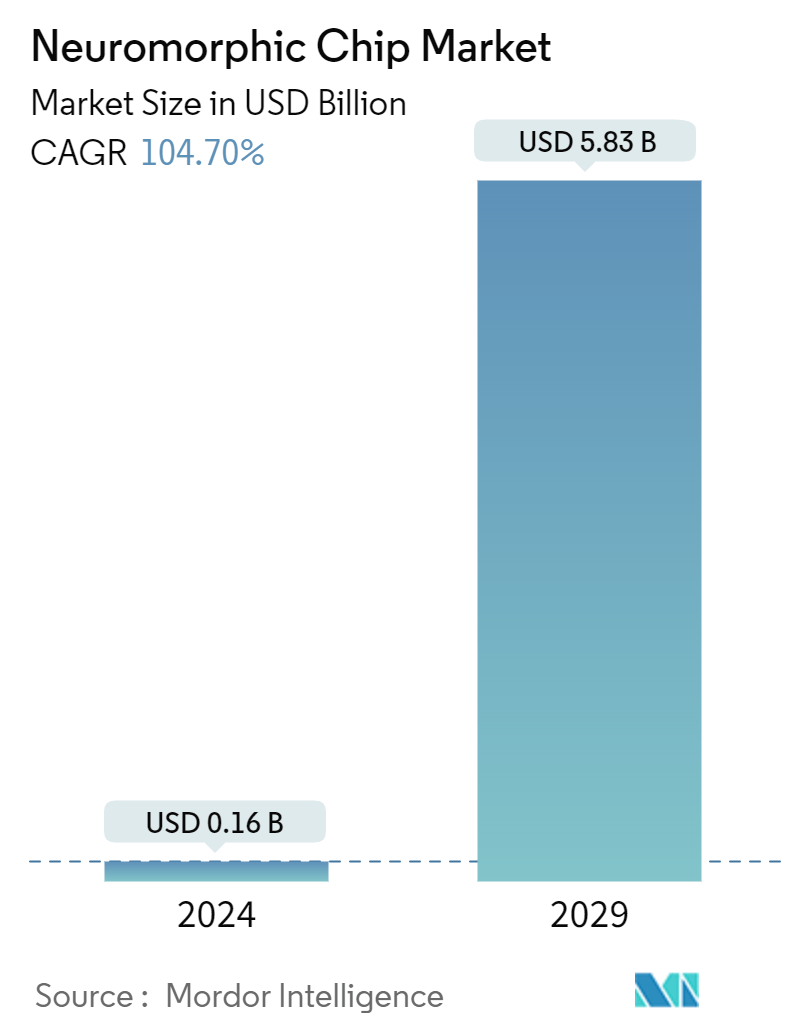
| Study Period | 2019 - 2029 |
| Market Size (2024) | USD 0.16 Billion |
| Market Size (2029) | USD 5.83 Billion |
| CAGR (2024 - 2029) | 104.70 % |
| Fastest Growing Market | Asia-Pacific |
| Largest Market | North America |
Major Players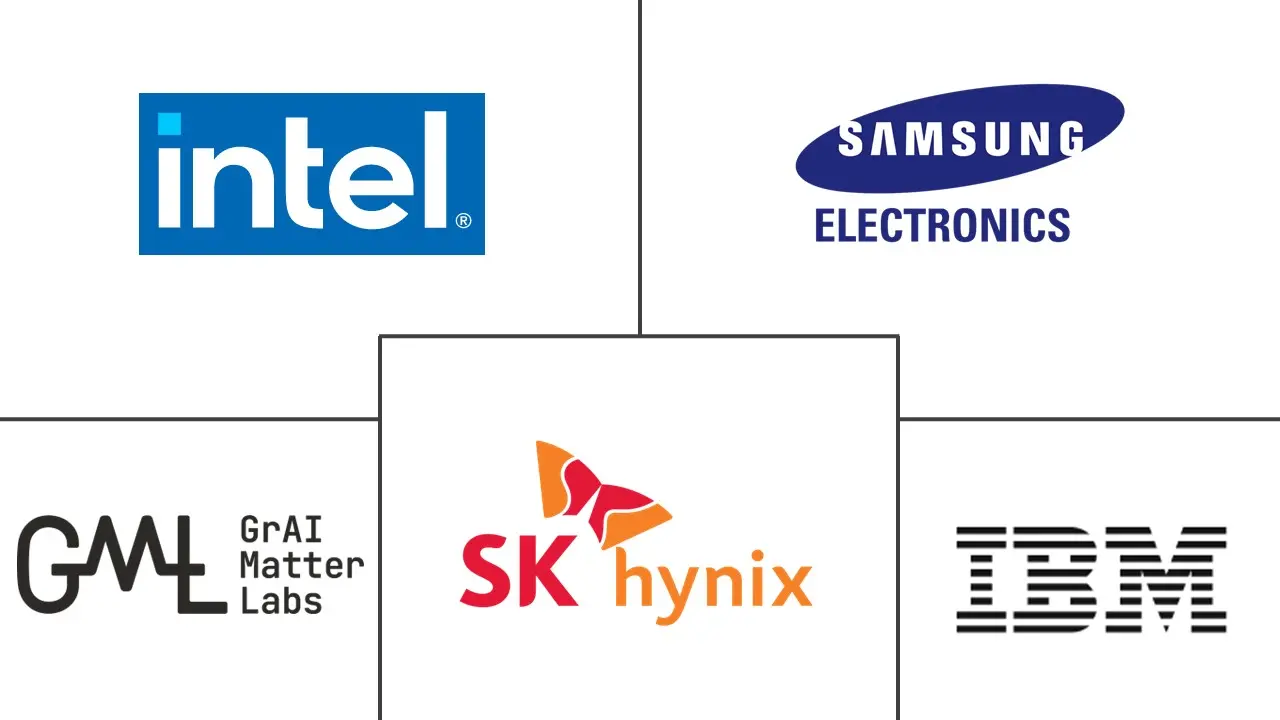
*Disclaimer: Major Players sorted in no particular order |
Neuromorphic Chip Market Analysis
The Neuromorphic Chip Market size is estimated at USD 0.16 billion in 2024, and is expected to reach USD 5.83 billion by 2029, growing at a CAGR of 104.70% during the forecast period (2024-2029).
• The increasing use of biometrics and in-speech recognition drives the demand for neuromorphic chips in smartphones. These chips are used to process audio data in the cloud and then return it to the phone. In addition, Artificial Intelligence (AI) requires more computing power, but low-energy neuromorphic computing could significantly push applications that run presently in the cloud to run directly in the smartphone in the future without substantially draining the phone battery.
• Neuromorphic is a specific brain-inspired ASIC that implements the Spiked Neural Networks (SNNs). On average, it has an object that can reach a massively parallel brain processing ability in tens of watts. The memory and the processing units are in single abstraction (in-memory computing).
• This leads to the advantage of dynamic, self-programmable behavior in complex environments. Instead of traditional bit-precise computing, neuromorphic hardware leads to the probabilistic models of simple, reliable, robust, and data-efficient computing as the brain's highly stochastic nature. Neuromorphic hardware certainly suits more cognitive applications than precise computing.
• During the next decade, neuromorphic computing will transform the nature and functionalities of a wide range of scientific and non-scientific applications. Some of them include mobile applications that are increasingly demanding powerful processing capacities and abilities.
• The design of neuromorphic chips follows the goal of modeling parts of the biological nervous system. The aim is to reproduce its computational functionality, especially its ability to efficiently solve cognitive and perceptual tasks. Achieving this requires modeling networks of sufficient complexity regarding the number of neurons and synaptic connections. The brain and its ability to learn and adapt to specific problems are still subject to basic neuroscientific research.
• The telltale spike in energy demand resulting from neuromorphic computing devices using potentially very small quantities of electricity makes hardware attacks much easier to identify. This increase would be visible through side-channel monitoring. Neuromorphic device designers may use brain functionality as a blueprint to create computing systems that use 3D nanostructures, biomaterials, redox memristors, magnetic neural network crossbar arrays, and other technologies.
• The COVID-19 pandemic had a favorable influence on the medical business market. Several market leaders, including IBM, Hewlett Packard, and Qualcomm, pushed their neuromorphic computing solutions into several hospitals and clinics worldwide. Their technologies' computational skills were able to reduce various difficulties inside a normal hospital ecosystem. The pandemic kept the capital equipment sector humming with a strong demand for next-generation electronics.
Neuromorphic Chip Market Trends
Consumer Electronics Segment Holds Significant Market Share
• The consumer electronics industry identifies neuromorphic computing as a promising tool for enabling high-performance computing and ultra-low power consumption to achieve these goals. For instance, AI services like Alexa and Siri rely on cloud computing and the internet to parse and respond to spoken commands and questions. Neuromorphic chips have the potential to allow several varieties of sensors and devices to perform intelligently without requiring an internet connection.
• Smartphones are expected to be the trigger for the introduction of neuromorphic computing. Several operations, such as biometrics, are power-hungry and data-intensive. For instance, in speech recognition, audio data is processed in the cloud and then returned to the phone.
• Wearable devices are a fast-growing technology with a considerable impact on personal healthcare for both the economy and society. Due to widespread sensors in pervasive and distributed networks, power consumption, processing speed, and system adaptation are vital in the future of smart wearable devices. Additionally, the field of artificial intelligence further boosts the possibility of smart wearable sensory systems. The emerging high-performance systems and intelligent applications need more complexity and demand sensory units to describe the physical object accurately.
• Advanced functions like image identification and natural language processing are becoming possible for wearables due to dedicated neuromorphic devices like IBM’s TrueNorth. In an emergency, neuromorphic wearables can notify medical personnel, monitor vital signs, identify abnormalities, and respond promptly.
• The increasing interest in neuromorphic engineering shows that hardware-spiking neural networks are considered a critical future technology with high potential in crucial applications, such as edge computing and wearable devices.
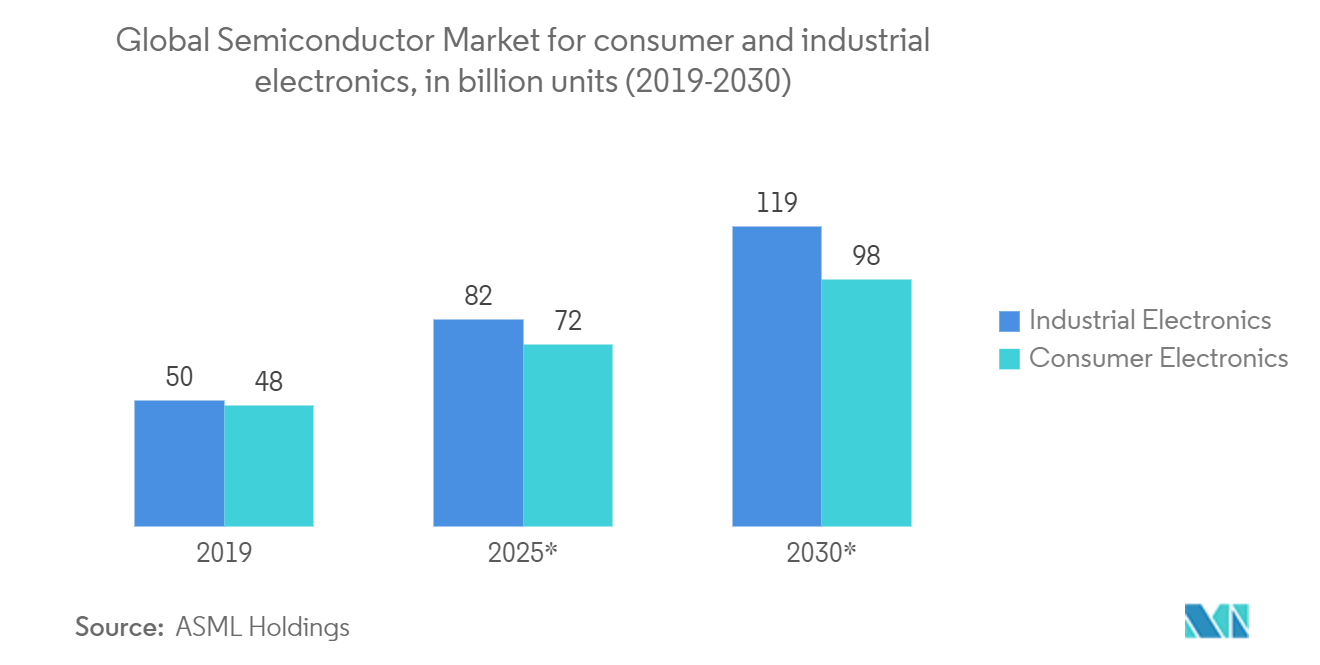
North America to Hold Major Share over the Forecast Period
• North America is home to some of the major market vendors, such as Intel Corporation and IBM Corporation. The market for neuromorphic chips is growing in the region due to factors such as government initiatives, investment activities, and others.
• For instance, in September 2023, In order to facilitate quick advancements in novel semiconductor technologies and manufacturing as well as workforce development, the US National Science Foundation announced 24 research and education initiatives totaling USD 45.6 million, including financing from the “CHIPS and Science Act of 2022”. The NSF Future of Semiconductors (FuSe) program funds the initiatives in conjunction with four companies, Samsung, Ericsson, IBM, and Intel, through a public-private collaboration.
• On the other hand, the government of Canada is focusing on artificial intelligence technology, which is also expected to create a scope for growth in neuromorphic computing over the coming years. For instance, in June 2023, the government of Canada proposed a new Artificial Intelligence and Data Act (AIDA) to address the potential risks of AI, build trust in Canada’s AI industry, and protect Canadians from a range of harms. AIDA will ensure that Canada is home to the world's most responsible and trusted AI.
• Several research projects are attracting collaborations for advancements in neuromorphic technology. For instance, in June 2023, Los Alamos National Laboratory announced the development of the new interface-type memristive device, which their results suggest can be used to build artificial synapses for next-generation neuromorphic computing.
• The increasing defense expenditure of various countries is also expected to drive the demand for neuromorphic computing in North America.
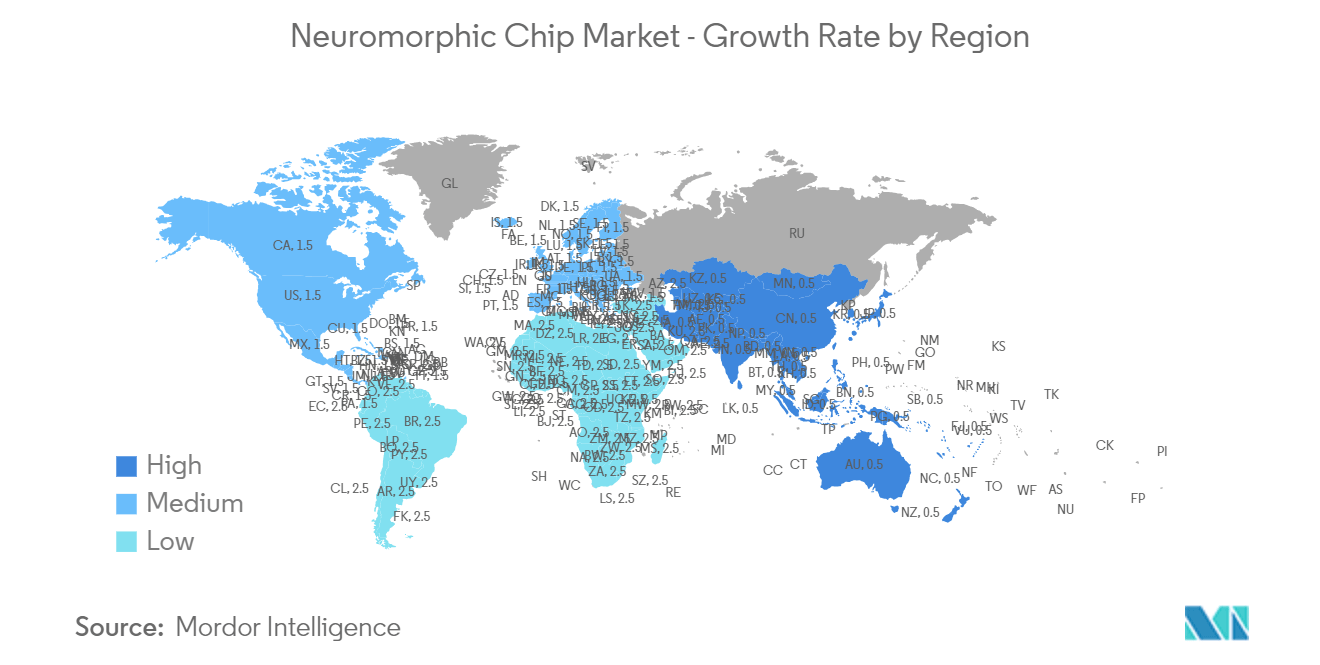
Neuromorphic Chip Industry Overview
The neuromorphic chip market has large-scale semiconductor vendors that command significant revenue generation capabilities, architecture-development start-ups, and universities. The market is consolidated, and vendors are increasingly spending on R&D and collaboration activities to gain technological capabilities and commercialize the market, making the market less competitive.
Despite neuromorphic chips being at an early stage of development, the patent filing activity by players in the market is gaining interest across key semiconductor companies, R&D centers, and universities, and competitive rivalry is poised to increase in the future.
• In June 2023, BrainChip Holdings Ltd and Lorser Industries Inc. announced that they would use BrainChip’s Akida technology to deliver neuromorphic computing solutions for software-defined radio (SDR) devices. The partnership will leverage Lorser’s expertise in SDR design and manufacturing and BrainChip’s cutting-edge neuromorphic technology to create innovative, intelligent solutions that enhance SDR devices' adaptability, reliability, and scale.
• In April 2024, Chip maker Intel announced that to facilitate more sustainable artificial intelligence (AI), it has constructed the largest neuromorphic system in the world, known as ”Hala Point.” This massive neuromorphic system, which was first implemented at Sandia National Laboratories, makes use of Intel’s “Loihi 2” CPU, supports research into future brain-inspired artificial intelligence, and addresses issues with the effectiveness and sustainability of current AI.
Neuromorphic Chip Market Leaders
-
Intel Corporation
-
SK Hynix Inc.
-
IBM Corporation
-
Samsung Electronics Co. Ltd
-
GrAI Matter Labs
*Disclaimer: Major Players sorted in no particular order
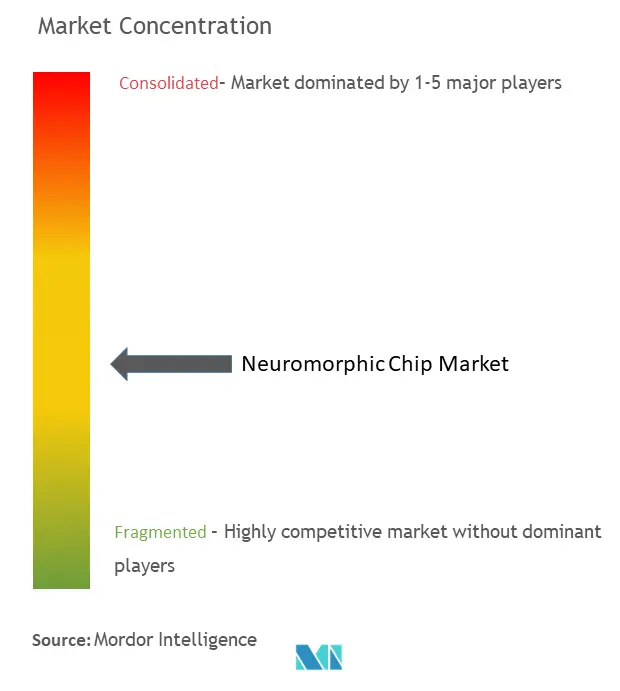
Neuromorphic Chip Market News
• March 2024: Using neuromorphic computing technology, a research team at KAIST created the first artificial intelligence (AI) semiconductor in history to compute a large language model (LLM) with extremely low power consumption. By creating integrated circuits resembling the human nervous system, technology hopes to enable chips to carry out increasingly complex tasks that require flexibility and reasoning while using less energy.
• September 2023: SynSense, the top commercial provider of ultra-low-power neuromorphic hardware and application solutions worldwide, released the Xylo IMU neuromorphic development kit (HDK). This new HDK allows users to create IMU-based motion processing applications for industrial monitoring, human movement analysis, and human-computer interaction. With support for training and deploying SNN models for Xylo IMU, SynSense’s open-source Python toolchain rockpool allows developers to investigate new use cases and research applications.
Neuromorphic Chip Market Report - Table of Contents
1. INTRODUCTION
- 1.1 Study Assumptions and Market Definition
- 1.2 Scope of the Study
2. RESEARCH METHODOLOGY
3. EXECUTIVE SUMMARY
4. MARKET INSIGHTS
- 4.1 Market Overview
-
4.2 Industry Attractiveness - Porter Five Forces
- 4.2.1 Bargaining Power of Suppliers
- 4.2.2 Bargaining Power of Buyers
- 4.2.3 Threat of New Entrants
- 4.2.4 Threat of Substitute Products
- 4.2.5 Intensity of Competitive Rivalry
- 4.3 Industry Value Chain Analysis
- 4.4 Emerging Use Cases for Neuromorphic Chips
- 4.5 Assessment of the Impact of COVID-19 on the Market
5. MARKET INSIGHTS
-
5.1 Market Drivers
- 5.1.1 Increasing Demand for Artificial Intelligence-based Microchips
- 5.1.2 Emerging Trend of Combining the Concept of Neuroplasticity with Electronics
-
5.2 Market Challenges
- 5.2.1 Need for High Level of Precision and Complexity in Hardware Design
6. GLOBAL DEEP LEARNING MARKET ANALYSIS
- 6.1 Current market scenario
-
6.2 Global Deep Learning Market Segmentation
- 6.2.1 By Type
- 6.2.1.1 CPU
- 6.2.1.2 GPU
- 6.2.1.3 FPGA
- 6.2.1.4 ASIC
- 6.2.1.5 SoC Accelerators
- 6.3 Coverage on the Current Trends in the Deep Learning Software and Service industry
- 6.4 Investment Scenario
- 6.5 List of Major Hardware Vendors
- 6.6 Future of the Market
7. MARKET SEGMENTATION
-
7.1 By End-User Industry
- 7.1.1 Financial Services and Cybersecurity
- 7.1.2 Automotive (ADAS/Autonomous Vehicles)
- 7.1.3 Industrial (IoT Ecosystem, Surveillance, and Robotics)
- 7.1.4 Consumer Electronics
- 7.1.5 Other End-user Industries (Medical, Space, Defense, Etc.)
-
7.2 By Geography
- 7.2.1 North America
- 7.2.2 Europe
- 7.2.3 Asia Pacific
- 7.2.4 Rest of the World
8. COMPETITIVE LANDSCAPE
-
8.1 Company Profiles
- 8.1.1 Intel Corporation
- 8.1.2 SK Hynix Inc.
- 8.1.3 IBM Corporation
- 8.1.4 Samsung Electronics Co. Ltd
- 8.1.5 GrAI Matter Labs
- 8.1.6 Nepes Corporation
- 8.1.7 General Vision Inc.
- 8.1.8 Gyrfalcon Technology Inc.
- 8.1.9 BrainChip Holdings Ltd
- 8.1.10 Vicarious FPC Inc.
- 8.1.11 SynSense AG
- *List Not Exhaustive
9. INVESTMENT ANALYSIS
10. FUTURE OF THE MARKET
** Subject To AvailablityNeuromorphic Chip Industry Overview
Neuromorphic chips are digitally-processed analog chips with a series of networks similar to human brain networks. These chips contain millions of neurons and synapses to augment self-intelligence, irrespective of pre-installed codes in normal chips. Neuromorphic chips, as a special kind of chip, can manipulate data received through sensors. For the study, chips that adopt the SNN approach have been considered part of the scope. The market studied tracks deep learning hardware and neuromorphic chips as separate markets.
The Neuromorphic Chip Market is segmented by End-User Industry (Financial Services & Cybersecurity, Automotive (ADAS/Autonomous Vehicles), Industrial (IoT Ecosystem, Surveillance, and Robotics), Consumer Electronics), Geography (North America, Europe, Asia Pacific, Rest of the World). The market sizes and forecasts are provided in terms of value (USD) for all the above segments.
| By End-User Industry | Financial Services and Cybersecurity |
| Automotive (ADAS/Autonomous Vehicles) | |
| Industrial (IoT Ecosystem, Surveillance, and Robotics) | |
| Consumer Electronics | |
| Other End-user Industries (Medical, Space, Defense, Etc.) | |
| By Geography | North America |
| Europe | |
| Asia Pacific | |
| Rest of the World |
Neuromorphic Chip Market Research FAQs
How big is the Neuromorphic Chip Market?
The Neuromorphic Chip Market size is expected to reach USD 0.16 billion in 2024 and grow at a CAGR of 104.70% to reach USD 5.83 billion by 2029.
What is the current Neuromorphic Chip Market size?
In 2024, the Neuromorphic Chip Market size is expected to reach USD 0.16 billion.
Who are the key players in Neuromorphic Chip Market?
Intel Corporation, SK Hynix Inc., IBM Corporation, Samsung Electronics Co. Ltd and GrAI Matter Labs are the major companies operating in the Neuromorphic Chip Market.
Which is the fastest growing region in Neuromorphic Chip Market?
Asia-Pacific is estimated to grow at the highest CAGR over the forecast period (2024-2029).
Which region has the biggest share in Neuromorphic Chip Market?
In 2024, the North America accounts for the largest market share in Neuromorphic Chip Market.
What years does this Neuromorphic Chip Market cover, and what was the market size in 2023?
In 2023, the Neuromorphic Chip Market size was estimated at USD -0.01 billion. The report covers the Neuromorphic Chip Market historical market size for years: 2019, 2020, 2021, 2022 and 2023. The report also forecasts the Neuromorphic Chip Market size for years: 2024, 2025, 2026, 2027, 2028 and 2029.
Neuromorphic Chip Industry Report
The Global Neuromorphic Computing Market report covers market share and growth, segmented by end-user industry such as financial services and cybersecurity, automotive (ADAS/autonomous vehicles), industrial (IoT ecosystem, surveillance, and robotics), and consumer electronics. The report offers a comprehensive industry analysis, providing insightful industry information and a detailed industry outlook. It includes industry reports that delve into industry research, industry sales, and industry size, offering a thorough understanding of industry statistics and industry trends.
The market data presented in the report includes a detailed market forecast, highlighting expected market growth and identifying market leaders. The market outlook and market overview sections provide a clear picture of the market's current state and future potential. The report also includes market predictions and a market review, ensuring that readers are well-informed about market segmentation and market value.
Additionally, the report includes a report example and a report PDF, offering a convenient way to access the research. The research companies involved in the compilation of this report have ensured that it is a valuable resource for understanding the neuromorphic computing market. The market share, market size, and market growth are all thoroughly analyzed, providing a complete market analysis. The market forecast and market trends sections offer insights into future developments, making this report an essential tool for anyone interested in the neuromorphic computing market.



